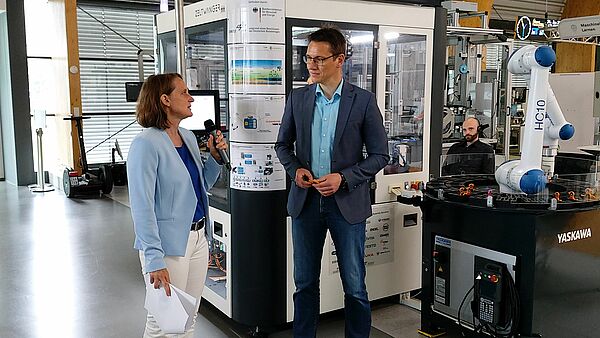The Digital Twin attracted 50 participants from business and science to the SmartFactoryOWL. Current projects on the digital twin were presented briefly and concisely. Thus, the Lemgo location once again proves itself as a technology center for topics related to Industry 4.0. The four-hour event offered an insight into the real demonstrators of the reallab as a live streaming event. This clearly set the event apart from the PowerPoint presentations that are often the norm.
Organized by the CENTRUM INDUSTRIAL IT (CIIT), two exciting contributions from our institute were presented.
Are our machines safe?
Our colleague Marco Ehrlich and his colleague Philip Kleen from Fraunhofer IOSB-INA explained the topic of "machine safety" using the example of a smart warehouse. The demonstrator serves as a practical example to answer questions of everyday automation. Is it permissible to store a new product or are new parameters, profiles and travel paths of the drives still safe? The answers developed in the research project "Automatic Evaluation and Monitoring of Safety and Security Properties for Intelligent Technical Systems (AutoS²)" were presented in an entertaining way.
Digital twins talk about OPC UA
Standardized concepts are needed for the representation of the digital twin and semantic interoperability. Prof. Dr. Henning Trsek explained why the concept of the management shell and its implementation by means of OPC UA is ideally suited, especially with regard to the operating phase of a machine, using the VDMA OPC UA Demonstrator (manufacturing cell for fidget spinners), which was further developed into a virtual presentation platform around the topic of "digital twins". We developed this together with the VDMA Service-oriented Architecture and real-time control (SOArc) working group, building on the results of the DEVEKOS research project successfully completed this year.
Our colleague André Mankowski took us on a virtual discovery tour of the manufacturing cell (https://digitaltwin-vdma.org/). This allows anyone to navigate through the object-oriented architecture of the plant. The practical example shows the added value of cross-vendor interoperability based on digital twins implemented with OPC UA. Almost every component of the cell represents itself as a digital twin (OPC UA node) and thus provides all kinds of information and interaction options. For example, component capabilities - so-called skills - can be executed or process data can be monitored via standardized interfaces. This allows control sequences to be created or process analyses to be carried out for optimization.


